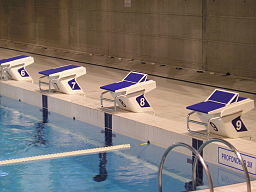SWIM DIVES…
Exhilarating. Effective. Enlivening. Exciting. Electric. Efficient.
You gain so much power and propulsion from the spring, the dip, and the glide … It is said to account for 26.1% of a fifty meter race and is, therefore, the easiest way to save energy and improve your swim time.

olovedog via Freedigitalphotos.net
You’ve seen it done before… but do you actually know all that goes into the dive and what strategies make it most effective? A little more here, a little less there, tweak that, do this … and all of the sudden, you’ve gone twice as far, twice as fast. “How?” You may ask…. Read below to find out:

Sabjarod photo via Wikimedia
Since this is the phase of your swim where you start your race, it is very important. This phase of your dive can also be considered your “reaction time”.
You don’t want to hesitate off the edge of the pool lake, or in a competition, the starting block.
Make sure your footing is stable. You should have an equal amount of weight on both legs. That will allow for a powerful take-off. If there is power in your initial jump, you will have a better chance at a good angle of entry into the water.
Just as if you were about to start a track race, both feet should be facing forward (you want them to face the direction that you intend your body to go). And one foot should be behind the other. Your hands should grip the edge of the block, the dock, the ground, or whatever it is you are jumping off off. Your arms should remain straight and tense.
Keep them unbent. This allows you to activate your arm muscles faster as you explode off the block.

David Shankbone via Wikemedia
This is the phase of your dive directly after you spring off the edge of the pool or the block. It is also directly before you enter the water.
It is the space of time that you are in the air. Every other part of your dive after this is in the water.
Make sure to utilize your arms in this phase. Coupled with a quick reaction in the starting phase, the transition to arms jetting straight out propels momentum forward. Bring your arms over your head and place your right hand over your left (or vice versa if preferred).
There are various angles suggested for this phase: pike, flat, flight lift… They all have the same theory in mind. Try to control the angle at which you hit the water and plan your flight phase accordingly.

Image courtesy of topendsports.com
This is the part of your dive where your hands hit the water.
It is the start of the water phase. The angle at which you submerge is very important and has a lot of effect on the rest of your dive.
The angle determines how much speed you carry with you into the water and also how much momentum you retain in a forward direction.
Pay attention to hand entry angle, shoulder entry angle, hip entry angle, ankle entry angle, and hip angle at hand entry.
If you master this phase, you will have an advantage over your competitors.
 4. Underwater phase:
4. Underwater phase:This is the period of the dive that is spent under the water.
There is a lot of research on this phase of the dive as it has a huge impact on the conversion of speed that is carried into the stroke.
This is also sometimes called the “Glide Phase.” Or the duration between the feet entering the water and the first underwater kick.
According to a scientific study, swimmers start their kick too soon. On average, 1.69 meters too soon. You can maximize the glide phase and the power it provides by holding out a little longer before the first kick.
Safety
-Make sure you are diving in a pool with proper depth. If the pool is too shallow, you may injure yourself and hit the bottom. You could have a spinal cord injury or possibly even die.
-Make sure the surface you dive off of isn’t too slippery.
-If you are diving into a natural body of water. Check for obstacles in your way before entry.
What your secret to perfect Swim Dives?
What’s your definition of a perfect starting dive during swimming?
How do you maintain and maximize speed?


Leave a comment
All comments are moderated before being published.
This site is protected by hCaptcha and the hCaptcha Privacy Policy and Terms of Service apply.